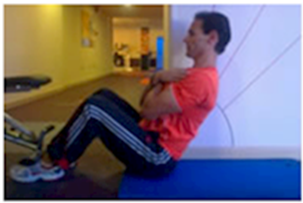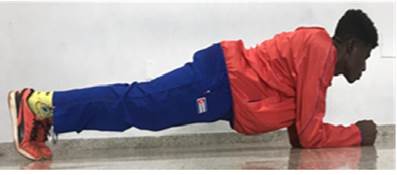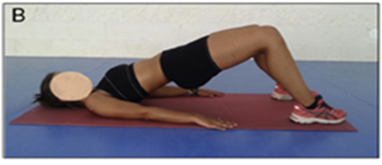Mi SciELO
Servicios Personalizados
Revista
Articulo
Indicadores
-
 Citado por SciELO
Citado por SciELO
Links relacionados
-
 Similares en
SciELO
Similares en
SciELO
Compartir
Podium. Revista de Ciencia y Tecnología en la Cultura Física
versión On-line ISSN 1996-2452
Rev Podium vol.17 no.1 Pinar del Río ene.-abr. 2022 Epub 24-Abr-2022
Original article
Study of the stabilizing muscles and the most frequent injuries in baseball 5 players
1Universidad de Ciencias de la Cultura Física y el Deporte "Manuel Fajardo". La Habana, Cuba.
3Instituto Universitario Amerike. México
Baseball, also called pelota (Spanish voice), is a team sport played between two teams of nine players each. It is considered one of the most popular sports in Australia, Canada, Colombia, Cuba, Dominican Republic, Holland, Italy, Japan, Mexico, Nicaragua, Panama, Puerto Rico, South Korea, South Africa, Taiwan, United States, and Venezuela. The countries considered the powers of this sport are concentrated in America (North, Central and Caribbean) and Asia, with the European and African continents lagging behind. The study allowed evaluating the strength resistance of the stabilizing muscles in 11 baseball 5 players of the "Manuel Fajardo" University of Physical Culture and Sport Sciences. A survey of the most frequent injuries in this sport was carried out. The research was carried out with a non-experimental design of minimal control with pretest-posttest for a single group. The methods used were analytical-synthetic, survey and measurement. The Cron's alpha Cronbach's alpha coefficient was used to obtain the test-retest reliability of the internal consistency of the EVAL-MEB5 instrument. The instrument was applied to the sample in 2 measurements with time intervals of one week. The main results reveal that the most frequent injuries reported in the diagnosis were: pitcher's elbow, pitcher's shoulder, young baseball player's elbow, meniscus degeneration, tendinitis and bursitis. The instrument showed a test-retest reliability of 91 % and therefore presents a good reliability. The strength endurance capacity of the stabilizing muscles in the Supine Ulnar Bridge, Isometric Squat 900 to the wall and Trunk isometric was found to be deficient.
Keywords: Tests; Resistance to force; Stability Muscle.
INTRODUCTION
Baseball, also called pelota (Spanish voice), is a team sport played between two teams of nine players each. It is considered one of the most popular sports in Australia, Canada, Colombia, South Korea, Cuba, the United States, Holland, Italy, Japan, Mexico, Nicaragua, Panama, Puerto Rico, the Dominican Republic, South Africa, Taiwan and Venezuela. The countries considered to be powers in this sport are concentrated in America (North, Central and Caribbean) and Asia, with the European and African continents lagging behind. However, Europe has two good exponents (Holland and Italy); and in Africa only the South African team, which has some good talents, is worth mentioning. Baseball in Cuba is a passion. It is practiced all over the archipelago. Cuba is considered one of the world powers in this sport Figueredo (2003).
Baseball 5 is a variation of baseball game. There are five players on each team and each team has five innings. It has been played all over Cuba and in every neighborhood in Cuba. Several of the National Series ballplayers started in the streets playing baseball 5 or a la manito as it is popularly known Figueredo (2003) and Kenn (2005).
The World Baseball and Softball Confederation proposed the game in 2018, the idea was born when several federators on a visit to the island paid attention to the Cuban four corners and decided to adopt it because it is a fast, dynamic game that does not need resources Figueredo (2003) and Kenn (2005).
Injuries that occur during baseball practice 5, some occur accidentally, others may be the result of improper training practices or improper use of training equipment.
Baseball 5, as in conventional baseball, has similarities in terms of the injuries it presents, being the shoulder joint the most affected due to the constant hitting of the ball and the pitches thrown by the field players.
Baseball 5 currently has the necessary elements for its training; however, it lacks a methodological instrument to evaluate the stabilizing muscles and postural segmental stability in practitioners of the "Manuel Fajardo" University of Physical Culture and Sport Sciences (UCCFD) with a view to preventing injuries and improving their performance.
In this study, several researches related to sports injuries focused on ball sports, currently called sports games, were taken into account (Gómez-Espejo et al., 2017; Ojeda et al., 2019; Monsalve, 2020; Ríos et al., (2019); Rodríguez et al., 2021, Crespo, 2021).
The research focuses on evaluating the stabilizing muscles and postural segmental stability in baseball 5 players of the UCCFD "Manuel Fajardo" with a view to preventing injuries and improving their performance.
In order to carry out this study it was necessary to consult and assume some evidence, extracted from the following authors: George and Mallery, (2003); Vera et al, (2015), Heredia et al, (2012); López et al., (2019); (Rodríguez, 2021).
MATERIALS AND METHODS
The research has a holistic character since it develops the description of facts and phenomena from the qualitative to the quantitative. The type of design is non-experimental. In terms of variable control, it is of minimal control with pretest-posttest for a single group. The research study is descriptive.
From a population of 20 baseball 5 players at the UCCFD Manuel Fajardo, 11 male subjects were selected according to the criteria of intentional selection:
To have completed the two rounds of evaluation tests for the stabilizing muscles.
Only perform the training and practice of baseball 5 in the time stipulated for the completion of the tests.
The group is composed of second shortstop, first base and third base players and three in the middle infield for an average of 23 years old, 1.65 years of height, 67.75 body weight for a BMI of 24.95 kg/m2 being normal allowing them to perform adequately in the different specific technical gestures of baseball 5.
The research was conducted by the Study Center for Physical Activity, Sport and Health Promotion "CEADES" during 2019.
For the development of this research, different tests were used, which were extracted from the following sources:
The questionnaire was designed to determine the level of preparation of the athletes and trainers regarding the knowledge of strength resistance training of the stabilizing muscles. In addition, the athletes were asked about the causes of their main injuries.
The strength resistance of the stabilizing muscles in baseball 5 players is evaluated through the measurement method.
A testing protocol was developed to evaluate the strength resistance of the stabilizing muscles in baseball players5 and we named it EVAL-MEB5.
Tests included in the EVAL-MEB5 instrument
Trunk flexor endurance test (ABD600): this test involves the main trunk flexor muscles, i.e. the rectus abdominal (Figure 1).
Prone bridge test (PP): isometric test to fundamentally assess the anterior and posterior muscular resistance of the core. The stipulated time to be endured by the tested subjects must be at least 60 seconds (Figure 2).
Modified Biering-Sorensen test or Isometric trunk test (ISOT): this test activates the main trunk extensor muscles, the longissimus and the multifidus (Figure 3).
Isometric squat test at 90oto the wall (ISOSC): the posture primarily assesses the muscular endurance of the rectus anterior, vastus externus, vastus internus and crural muscles. The Core muscle complex must be activated and the lumbar region as close to the wall as possible. The subject adopts the posture shown in figure 4b and will have to maintain the same posture, without modifying it, for as long as possible (Figure 4b).
Isometric test in pelvic elevation (ISOEP): the posture involves the main muscles that elevate the pelvis and form the extensor muscles of the trunk. To achieve a correct posture you must keep the shoulder blades together, the lumbo pelvic complex, the abdomen and buttocks activated, which are the ones that stabilize the posture and the back as close to the floor as possible. The subject adopts the posture shown in the figure 5 and it will have to maintain the same posture, without modifying it, as long as possible (Figure 5).
The statistical processing of the results was carried out using the specialized software IBM SPSS Statistics version 22. For test-retest reliability, Cronbach's alpha coefficient was applied to estimate the internal consistency reliability of the EVAL-MEB5 instrument.
This work team set out to construct an instrument to evaluate the strength resistance of the stabilizing muscles in baseball 5 players, and we named it EVAL-MEB5. This is a valid instrument as long as it pursues what it is intended to measure or evaluate, and it is strengthened with statistical processing that evidences the strength of the instrument supported by its standardization, validity and reliability. Therefore, it is considered appropriate to obtain the reliability of the instrument as it was applied.
To determine the reliability of EVAL-MEB5, the test-retest method is applied, which corresponds to the most intuitive concept of reliability, since an instrument is reliable if it provides the same results in successive measurements.
The EVAL-MEB5 was applied to 11 baseball 5 athletes in two measurements with time intervals of one week, so that the subjects respond several times to the same test and thus the Correlation Coefficient between the two measurements applied is obtained and we call it the test-retest reliability coefficient.
If a large correlation is obtained, it indicates that in the two measurements the subjects have been ordered in the same or similar way. It is assumed that, if the test is accurate, the measures should be very similar and the test-retest reliability coefficient will tend to obtain results close to 1. If this is so, it is assumed that the test is reliable because, regardless of when it is applied, it tends to always obtain the same measure.
To apply this resource, the following recommendations are followed to evaluate Cronbach's alpha coefficients:
Coefficient alpha >.9 is excellent and represents 90 %.
Coefficient alpha >.8 is good and represents 80 %.
Coefficient alpha>.7 is acceptable and represents 70 %.
Coefficient alpha >.6 is questionable and represents 60 %.
Coefficient alpha >.5 is poor and represents 50 %.
Coefficient alpha <.5 is unacceptable and represents 50 %.
For the results obtained from the test-retest reliability of the EVAL-MEB5 instrument, we followed the criteria of the aforementioned authors and applied the Cronbach's Alpha reliability statistic and assumed the rating scale proposed by George and Mallery (this quote appears in detail in the introduction of this work).
The field procedure to apply the instrument was as follows:
Once selected, the contents of the instrument and how to fill it out were explained to them in detail. Before starting with the first measurement, a one-week pilot test of the sample was carried out, taking measurements day by day, so that they could become familiar with the instrument and gain experience and mastery. At the end of this stage, the EVAL-MEB5 was officially applied to the study sample by the specialists, who evaluated the 11 athletes separately, and the same procedure was carried out for two weeks.
RESULTS AND DISCUSSION
The respondents are university graduates and have a scientific level of master's degree in Methodology of training for high competition. Of the five respondents, three have five years of experience and two have ten years of experience. All of them are baseball coaches, and two of them are currently managing baseball 5 teams. Only two respondents allude to having knowledge of the stabilizing muscles. Only one coach correctly identified the stabilizing muscles in the three images shown to him. All of them refer that from the training they do prevent injuries and that they have not received any form of training on the training of the stabilizing muscles for the prevention of injuries. The most frequent injuries reported in the diagnosis were: pitcher's elbow, pitcher's shoulder, young baseball player's elbow, meniscus degeneration, tendonitis and bursitis (Table 1).
Table 1. - Descriptive statistical results of frequency of the instrument "EVAL-MEB5"
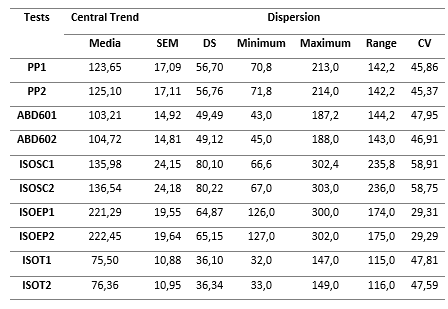
Legend: Prone Bridge test (PP). Trunk flexor endurance test (ABD600). Isometric squat at 90o to the wall (ISOSC). Isometric pelvic elevation (ISOEP). Modified Biering-Sorensen isometric trunk test (ISOT).
The results in Table 2 express the trend of similarity of the average values between the measurements, which fulfill the purpose of the tests and provide times of resistance to the strength of the stabilizing muscles between measurement 1 and 2 of a few seconds of difference, knowing that the week of rest between one measurement and the other, those evaluated did not perform any exercise for the development of the stabilizing muscles, the tests fulfilled their purpose (Table 1).
It should be noted that the dispersion of the results in all the variables measured is high as reflected by the standard deviation, the range, being the difference between the maximum and minimum results, shows that the dispersions are reflected in the highest area of the results.
Considering the duration times supported for the strength endurance capacity of the stabilizing muscles: spinal erectors, multifidus, transversus abdominal in the supine cubitus bridge test, lateral vastus, medial and intermediacy and Sartorius in the isometric squat tests at 90o on the wall and spinal erectors, multifidus, transversus abdominal, serratus anterior, rhomboid and trapezium in the isometric trunk test are the weakest muscles found (Table 2).
Table 2. - Statistical results of the reliability test of the "EVAL-MEB5" instrument
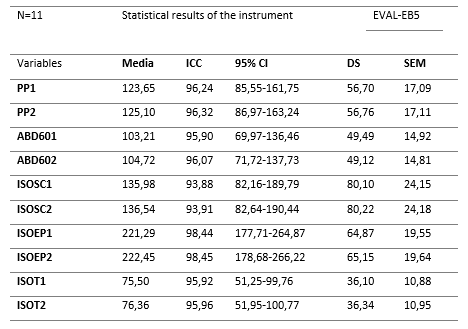
Legend: ICC: Intraclass Correlation Coefficient. CI: Confidence Interval. SD: Standard Deviation. SEM: Standard error of measurement. Prone bridge test (PP). trunk flexor strength test (ABD600). Isometric squat at 90o on the wall (ISOSC). Isometric pelvic elevation (ISOEP). Modified Biering-Sorensen test (1984) Isometric trunk test (ISOT).
It can be seen in the table 3 how the results of the Intraclass correlation coefficient in all the variables compared show good reliability because it is close to the 95% Confidence Interval. In relation to the reliability analysis, Koo and Li (2016) suggest that ICC values close to 1 are considered good, < 0.5 poor, to 0.50.75 moderate, 0.75 to 0.90 good and ≥ 0.90 excellent, therefore an ICC greater than 0.80 represent acceptable absolute and relative reliability levels. The results obtained in the study support the classical theory of tests and the socialization of the results with others in similar or different investigations. In relation to trunk muscular endurance field tests, few studies have analyzed absolute and relative reliability together. Most studies have analyzed relative reliability and have found ICC values above 0.75. The prone bridge and lateral bridge tests ICC 0.99 and the Biering-Sorensen Test (BST) ICC 0.77 as reported by Berglund et al., (2015), Coulombe et al., (2017), Chang et al., (2018), De Blaiser et al., (2018), Bohannon et al., (2018). The BST assesses trunk endurance, specifically the extensor muscles Garcia et al., (2018), playing a functional role in the complex tasks of the baseball training process 5.
The tests that evaluate the strength endurance of the trunk muscles and central stabilizers are useful and easy to perform. They can be part of the evaluation and control in the baseball 5 training process, as long as their specific and methodological characteristics for their application are respected (Table 3).
Next, the table 3 shows the calculation of the Cronbach's alpha coefficient, obtaining as a result ninety-one percent (91 %), which according to George and Mallery (2003, p. 231) the coefficient is good and the same reliability statistic for the test yielded a (92 %) also good, this translates into presenting a good reliability if applicable. It is assumed that the EVALMEB5 instrument is reliable and measures what it really wanted to measure "the resistance to the strength of the stabilizing muscles in the Besibol5 athletes of the UCCFD "Manuel Fajardo", knowing that regardless of when it is applied, it tends to always obtain the same measurement. The results coincide with those yielded by Kinoshita et al., (2015) , Ozcan et al., (2016) and Hernández and Barreral (2018).
CONCLUSIONS
The most frequent lesions found in the diagnosis were: pitcher's elbow, pitcher's shoulder, young baseball player's elbow, meniscus degeneration, tendonitis and bursitis. The EVAL-MEB5 instrument diagnosed deficiency in the strength endurance of the stabilizing muscles spinal erectors, multifidus, transversus abdominal in the supine cubitus bridge test, vastus laterals, medial and intermedial and Sartorius in the isometric squat test at 90o on the wall and spinal erectors, multifidus, transversus abdominal, serratus anterior, rhomboid and trapezium in the isometric test of the trunk.
REFERENCIAS BIBLIOGRÁFICAS
Berglund, L., Aasa, B., Hellqvist, J., Michaelson, P. and Aasa, U. (2015). Which patients With Low Back Pain Benefit From Deadlift Training?. J Strength Cond Res. 29(7). https://pubmed.ncbi.nlm.nih.gov/25559899/ [ Links ]
Bohannon, R.W., Steff, M., Glenney, S.S., Green, M., Cashwell, L., Prajerova, K., Bunn, J. (2018). The prone bridge test: Performance, validity and reliability among older and younger adults. J Bodyw Mov Ther. 22(2):385-389. https://pubmed.ncbi.nlm.nih.gov/29861239/ [ Links ]
Coulombe, B.J., Games, K.E, Neil, E.R., Eberman, L.E. (2017). Core Stability Exercise Versus General Exercise for Chronic Low Back Pain. J Athl Train. 52(1):71-72. https://pubmed.ncbi.nlm.nih.gov/27849389/ [ Links ]
Chang, N.J., Chou, W., Hsiao, P.C., Chang, W.D., Lo, Y.M. (2018). Acute effects of Kinesio taping on pain, disability and back extensor muscle endurance in patients with low back pain caused by magnetic resonance imagingconfirmed lumbar disc degeneration. J Back Musculoskelet Rehabil. 31(1):85-93. https://pubmed.ncbi.nlm.nih.gov/28800306/ [ Links ]
Crespo Madera, E. J., Costa Acosta, J., & Valdéz López Portill, M. R. (2021). Fundamentos físicos del gesto técnico del pitcher. Podium. Revista de Ciencia y Tecnología en la Cultura Física, 16(2), 332-344. http://scielo.sld.cu/scielo.php?script=sci_arttext&pid=S1996-24522021000200332 [ Links ]
De Blaiser, C., De Ridder, R., Willems, T., Danneels, L., Vanden, L., Palmans, T. and Roosen, P. (2018). Evaluating Abdominal core muscle fatigue: Assessment of the validity and reliability of the prone bridging test. Scand J Med Sci Sports. 28(2):391-399. https://pubmed.ncbi.nlm.nih.gov/28544083/ [ Links ]
García García, A. M., Ayala Zuluaga, C. F., Alzate Salazar, D. A., Aguirre Loaiza, H. H., Moreno Bolívar, H., Melo Betancourt, L. G., & Ramos Bermúdez, S. (2018). Metodología del entrenamiento deportivo. Editorial Universidad de Caldas. [ Links ]
George, D., & Mallery, P. (2003). SPSS for Windows Step by Step: A Simple Guide and Reference, 11.0 Update. Allyn and Bacon. https://books.google.com.cu/books/about/SPSS_for_Windows_Step_by_Step.html?hl=es&id=AghHAAAAMAAJ [ Links ]
Gómez-Espejo, V., Álvarez, I., Abenza, L., & Olmedilla, A. (2017). Análisis de la relación entre apoyo social y lesiones en futbolistas federados. Acción Psicológica, 14(1), 57-64. https://scielo.isciii.es/scielo.php?script=sci_abstract&pid=S1578-908X2017000100057 [ Links ]
Heredia Elvar, J. R., Isidro Donate, F., Mata Ordoñez, F., Moral, S., & Peña, G. (2012). Revisión de los Métodos de Valoración de la Estabilidad Central (Core). PubliCE, 0. https://g-se.com/revision-de-los-metodos-de-valoracion-de-la-estabilidad-central-core-1426-sa-g57cfb2720c148 [ Links ]
Hernández, H. A., & Barrera, A. E. P. (2018). Validación de un instrumento de investigacion para el diseño de una metodología de autoevaluación del sistema de gestión ambiental. Revista de Investigación Agraria y Ambiental, 9(1), 157-164. https://doi.org/10.22490/21456453.2186 [ Links ]
Kinoshita, K. Hashimoto, M., Ishida, K., Yoneda, Y., Naka, Y., Kitanishi, H., Oyagi, H., Hoshino, Y. And Shibanuma, N. (2015). A novel objective evaluation method for trunk function. J. Phys. Ther. Sci. 27(5): 1633-1636. https://pubmed.ncbi.nlm.nih.gov/26157279/ [ Links ]
Koo, T. and Li, M. (2016). A Guideline of Selecting and Reporting Intraclass Correlation Coefficients for Reliability Research. Journal of Chiropractic Medicine, 15(2), 155-63. http://doi.org/10.1016/j.jcm.2016.02.012 [ Links ]
López, R., Lalangui, J., Maldonado, A.V. y Palmero, D.E. (2019). Validación de un instrumento como garantía de la credibilidad en las investigaciones científicas. Revista Cubana de Medicina Militar, 48(2), 341-346. http://revmedmilitar.sld.cu/index.php/mil/article/view/390/331 [ Links ]
Ozcan, K., Salik, S., Kahraman, T. and Kalemci, O. (2016). Developing a Reliable Core Stability Assessment Battery for Patients with Nonspecific Low Back Pain. Spine; 41 (14): E844E850. https://pubmed.ncbi.nlm.nih.gov/26679886/ [ Links ]
Ojeda, Á. C. H., Sandoval, D. A. C., & Barahona-Fuentes, G. D. (2019). Métodos de entrenamiento propioceptivos como herramienta preventiva de lesiones en futbolistas: una revisión sistemática. Archivos de Medicina del Deporte. 36(3):173-180. https://www.researchgate.net/publication/336014124_Metodos_de_entrenamiento_propioceptivos_como_herramienta_preventiva_de_lesiones_en_futbolistas_una_revision_sistematica [ Links ]
Monsalve Vélez, F. (2020). Relación de las características clínicas, físicas y de entrenamiento asociadas a las pruebas positivas en hombro y codo en beisbolistas de la selección Antioquia 2019. Universidad CES. https://repository.ces.edu.co/handle/10946/4882?show=full . [ Links ]
Rodríguez, H. A. T., Barón, M. J. S., & Pérez, Y. T. (2021). Diseño y construcción de un algoritmo para el análisis deductivo y evaluación de la cinemática de los gestos deportivos de saque y remate de jugadores de voleibol. DESARROLLO E INNOVACIÓN EN INGENIERÍA, 624. [ Links ]
Ríos Garit, J., Pérez Surita, Y., Fuentes Domínguez, E., & Paredes, M. M. D. A. (2019). Efecto de las lesiones deportivas sobre variables psicológicas en lanzadores de béisbol. Podium. Revista de Ciencia y Tecnología en la Cultura Física, 14(3), 403-415. https://podium.upr.edu.cu/index.php/podium/article/view/843/html_1 [ Links ]
Figueredo, J. S. (2003). Cuban Baseball: A Statistical History, 1878-1961. McFarland & Company, Publishers. [ Links ]
Vera-García, F. J., Barbado, D., Moreno-Pérez, V., Hernández-Sánchez, S., Juan-Recio, C., & Elvira, J. L. L. (2015). Core stability: Evaluación y criterios para su entrenamiento. Revista Andaluza de Medicina del Deporte, 8(3), 130-137. https://sciencedirect.com/science/article/pii/S18887546715000258 [ Links ]
Received: November 18, 2021; Accepted: January 07, 2022











 texto en
texto en 


